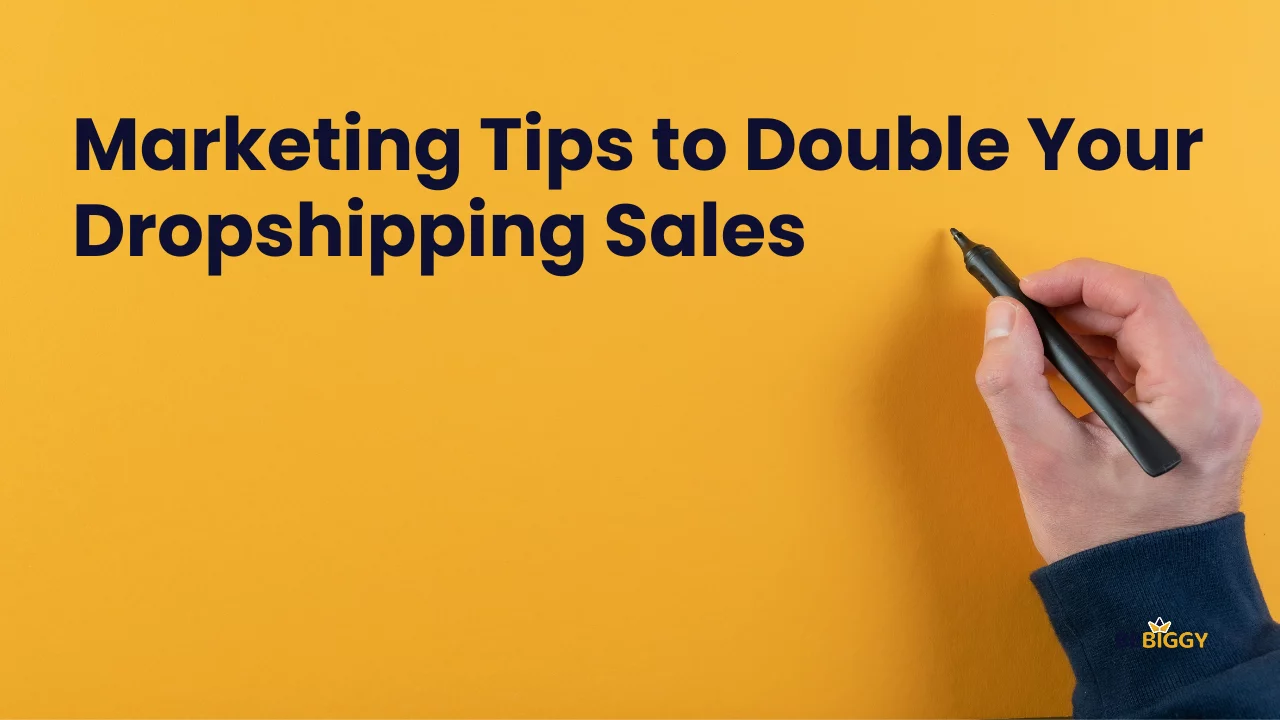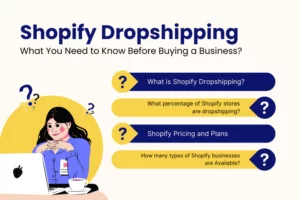Shopify dropshipping store design: insider techniques for guaranteed success!
Are you prepared to turn your Shopify store that leaves a lasting impression? Let’s embark on this exhilarating adventure together and discover the art of Shopify dropshipping store design – because in the realm of e-commerce, the journey to success is as thrilling as the destination itself.
What is Shopify?

Shopify is a platform that provides businesses and individuals with the tools to create and manage online stores. It offers features to help users set up digital storefronts, list and sell products, process payments securely, manage inventory, and execute online marketing campaigns.
How it works: user-friendly interface
Shopify is known for its user-friendly interface and versatility, making it suitable for small startups and large enterprises.
● Create your store: To start, sign up for an account and choose a subscription plan. You then personalize your online store by selecting a theme that fits your brand’s identity.
● Add Products: You can list your products in your Shopify store, complete with descriptions, images, and prices. Shopify makes it easy to organize and categorize your inventory.
● Secure Payment Processing: Shopify integrates with various payment gateways. It also offers its payment solution, Shopify Payments, which can help you with transaction fees.
● Manage Inventory: You can efficiently track your product stock, set up automatic restocking alerts, and manage your inventory with Shopify’s tools.
● Order Fulfillment: From the moment a customer places an order to the product’s delivery, Shopify streamlines the order fulfillment process. If you choose this business model, you can manage orders and integrate with dropshipping suppliers.
● Market Your Store: Shopify provides a range of marketing tools to help you attract customers. You can create and analyze online marketing campaigns, including email and social media advertising.
● 24/7 Support: If you have questions or issues, Shopify offers 24/7 customer support to assist you in your e-commerce journey.
● Global Reach: With support for multiple languages and currencies, Shopify allows you to reach a worldwide audience.
In essence, Shopify simplifies running an online store, making it accessible to users with various technical expertise. It’s designed to handle everything from website customization to secure payment processing, helping businesses focus on their products and customers.
What is Shopify store design?
Shopify store design refers to the visual and functional elements that make up an online store’s appearance and user experience built on the Shopify platform. It encompasses the following aspects:
● Themes: Shopify provides a variety of pre-designed themes that determine your store’s overall look and layout.
● Customization: Store owners can customize their chosen theme by adjusting colors, fonts, and other style elements to match their brand identity.
● Layout: Designing the layout of your store includes organizing product listings, collections, and navigation menus for an intuitive and user-friendly shopping experience.
● Product Pages: Optimizing individual product pages with high-quality images, detailed descriptions, prices, and call-to-action buttons is essential for conversions.
● Mobile responsiveness: ensuring your store is accessible and functional on mobile devices, as many consumers shop using smartphones and tablets.
● Navigation: Creating clear and logical navigation menus helps customers quickly find products and information.
● Brand Elements: Incorporating your brand’s logo, colors, and messaging throughout the store reinforces your brand identity and builds customer trust.
● Images and Multimedia: Using high-quality product images, videos, and multimedia elements to showcase products and engage customers
● Trust Signals: Including trust-building elements like security badges, customer reviews, and guarantees to boost confidence and credibility
● Loading Speed: Ensuring fast page loading times to prevent customers from bouncing due to slow loading
● Search Functionality: Implementing a robust search feature to help customers find products quickly.
Choosing Shopify website design templates

Shopify offers a wide selection of website design templates, known as themes, which can be applied to your online store to determine its overall look and layout. These themes are designed to accommodate various industries and styles. Some key points about Shopify website design templates include:
- Free and Paid Themes: Shopify provides premium (paid) themes. Free themes offer basic design options, while premium articles have more advanced features, customization options, and support.
- Customization: Themes can match your brand’s visual identity. You can adjust colors, fonts, layouts, and other style elements.
- Variety of Styles: Shopify themes cover various styles and industries, from fashion and electronics to home decor. Some themes are designed specifically for niche markets.
- User Reviews: Before selecting a theme, you can read user reviews and view previews to help you decide which one best suits your business.
- Shopify Theme Store: You can explore and select themes from the official Shopify Theme Store, where you’ll find a collection of free and paid themes.
- Third-Party Themes: In addition to Shopify’s official themes, you can also find themes developed by third-party companies that are compatible with the platform.
- Support and Updates: Premium themes often come with ongoing support and updates from their developers to ensure they remain compatible with the latest Shopify features and best practices.
When choosing a Shopify website design template, consider your brand, industry, and business goals. Ensure the selected theme aligns with your overall design and functionality requirements, providing your customers with the best shopping experience.
Step-by-step guide to the essentials of an excellent dropshipping website design:
- Choose the Right Platform: Opt for a reputable e-commerce platform like Shopify, WooCommerce, or BigCommerce, which offers user-friendly interfaces and customizable design options.
- Select a Clean and Professional Theme: Browse the platform’s theme store and choose a clean, professional theme that aligns with your brand and industry.
- Branding and Logo: Add your business logo and create a consistent branding scheme, including color palettes and fonts that reflect your brand identity.
- Intuitive Navigation: Organize your site’s navigation logically with clear menus, categories, and subcategories. Use descriptive labels to make it easy for customers to find products.
- High-Quality Product Images: Use high-resolution images to showcase your products.
- Compelling Product Descriptions: Write informative and persuasive product descriptions.
- User-Friendly Product Pages: Design product pages with clear and easy-to-find “Add to Cart” buttons. Include pricing, available sizes, colors, and variants.
- Trust Signals: Display trust signals like secure payment icons, SSL certificates, and customer reviews to build trust with your audience.
- Search Functionality: Implement a robust search bar that allows users to find specific products quickly. Consider adding an auto-suggest feature.
- Shopping Cart and Checkout Process: Streamline the shopping cart and checkout process. Minimize steps, offer guest checkout options, and show a progress bar.
- Payment and Shipping Information: Present payment and shipping options and policies. Include shipping costs and delivery times at the checkout stage.
- Contact Information: Provide easy access to your contact information, including an email address and a customer support phone number.
- Customer Support: Offer accessible customer support options, such as a live chat, email support, or a contact form.
- Privacy Policy and Legal Information: Include essential legal pages like a privacy policy, terms and conditions, and a return policy.
- Loading Speed: Optimize your website’s loading speed to keep potential customers engaged. Compress images and minimize plugins that can slow down your site.
- SEO Optimization: Implement on-page SEO strategies, including meta tags, alt tags for images, and keyword-rich product descriptions.
- Social Proof: To reassure potential buyers, display social proof elements, such as customer reviews and testimonials.
- Up-Selling and Cross-Selling: Use product recommendations to up-sell and cross-sell related items during shopping.
- Feedback and Improvement: Encourage customer feedback and reviews. Use this feedback to improve your website design and user experience.
Some tips for success when using Shopify for your e-commerce business:
- Choose the Right Niche: Select a niche that you are passionate about and has a target audience. Research the niche’s demand, competition, and potential for growth.
- Quality Product Listings: Create detailed and compelling product listings. Use high-quality images, informative descriptions, and competitive pricing.
- Mobile Optimization: Ensure that your Shopify store is mobile-responsive. Many customers shop on mobile devices, so a mobile-friendly design is essential.
- Effective SEO: Optimize your product listings and website for search engines. Use relevant keywords and meta descriptions to improve your store’s visibility in search results.
- Fast Loading Speed: A fast-loading website is crucial for a positive user experience. Use optimized images and reliable hosting to reduce loading times.
- Secure Payment Options: Offer multiple secure payment options to accommodate customer preferences. Using Shopify Payments can simplify payment processing.
- Customer Reviews: Encourage customer reviews and ratings on your products. Positive reviews can build trust and influence potential buyers.
- Content Marketing: Utilize a blog or content marketing strategy to provide value to your audience.
- Abandoned Cart Recovery: Implement abandoned cart recovery emails to win back customers who left without completing a purchase.
- Regular Updates: Keep your website and product listings up-to-date. Remove outdated products, update descriptions, and refresh your website’s design.
- Customer Support: Provide excellent customer support. Respond promptly to inquiries, resolve issues, and offer a smooth return process.
- Analytics and Tracking: Use Shopify’s built-in analytics and integrate Google Analytics to track your store’s performance. Analyze the data to make informed decisions.
- Continuous Learning: Stay updated with e-commerce trends and best practices. Attend webinars, read blogs, and learn from other successful Shopify store owners.
- Scalability: Plan for the future. As your business grows, consider upgrading your Shopify plan and expanding your product offerings.
- Testing and Optimization: Continuously test different strategies and optimize your store based on what works best.
- Shipping and Returns: Be transparent about shipping times and return policies. Clear communication can lead to satisfied customers.
- Security: Keep your store and customer data secure. Use SSL certificates and follow security best practices.
- Networking: Connect with other online and offline Shopify store owners to share experiences and insights.
Success on Shopify requires dedication, strategy, and adaptability. It’s an ever-evolving platform, and staying informed and customer-focused is key to building a thriving e-commerce business.
Steps to creating a dropshipping store on Shopify
Creating a dropshipping store on Shopify involves several steps. Here’s a simplified guide to help you get started:
Sign up for Shopify:
- Go to the Shopify website and click “Get Started.”
- Enter email address
- Create a password
- Choose a store name.
Set Up Your Store:
- After signing up, you’ll be prompted to enter basic business information.
- Fill in your store name, address, and other details.
Choose a Shopify Plan:
- Select a Shopify plan that suits your business needs. Shopify offers a variety of plans, including a 3-day free trial.
Select a theme:
- Choose a theme for your store’s design. Shopify offers both free and premium themes.
Customize your theme:
- Customize the selected theme to match your brand’s look and feel. You can modify colors, fonts, and layout to create a unique storefront.
Add Products:
- Start adding products to your store. Since you’re dropshipping, you won’t need to hold inventory. Use Shopify’s built-in tools to add products or install a dropshipping app.
Set Up Payment Gateway:
- Configure your payment processing settings. You can use Shopify Payments or other payment gateways to accept customer payments.
Organize your products:
- Organize your products into collections or categories to make it easier for customers to find what they want.
Set Up Shipping:
- Determine your shipping strategy. If you’re dropshipping, this often involves specifying shipping costs and times provided by your suppliers.
Configure Taxes:
- Set up tax settings based on your location and the location of your customers.
Set up legal pages:
- Create essential legal pages for your store, such as a Privacy Policy, Terms and Conditions, and Refund Policy.
Launch your store:
- Once everything is set up, you can launch your store and make it live.
Monitor Performance:
- Use Shopify’s analytics and reporting tools to track your store’s performance. Adjust your strategy based on data and customer feedback.
Customer Support:
- Offer excellent customer support to address inquiries and resolve issues promptly.
Expand and optimize:
- As your store grows, consider expanding your product range and optimizing your marketing strategies for better results.
Dropshipping is competitive, so successful marketing and product selection is essential. Continuously evaluate your products and marketing efforts to stay ahead in the e-commerce game.
How can I improve my dropshipping store?

To improve your dropshipping store and boost its chances of success, consider these strategies:
- Product Research: Identify high-demand, trending products to keep your catalog fresh and appealing.
- Customer Persona: Refine your understanding of your target audience and create marketing strategies that specifically cater to their needs and preferences.
- Website Design: Optimize your store’s design for a seamless user experience, including fast loading times, intuitive navigation, and mobile responsiveness.
- Product Descriptions: Craft compelling and informative product descriptions that highlight the benefits and features of your products.
- Pricing Strategy: Analyze your pricing strategy to ensure it remains competitive while allowing you to maintain healthy profit margins.
- SEO and Content Marketing: Invest in search engine optimization (SEO) and content marketing to improve your store’s visibility in search engine results.
- Social Media Marketing: Leverage social media platforms for marketing and customer engagement. Use visual content, engage with your audience, and run targeted ads.
- Customer Support: Provide excellent customer support by promptly addressing inquiries, resolving issues, and offering a hassle-free return process.
- Abandoned Cart Recovery: Implement automated email campaigns to recover abandoned carts and convert potential sales.
- Analytical Tools: Use analytical tools to track store performance, customer behavior, and sales trends. Make data-driven decisions for improvement.
- Quality Suppliers: Maintain strong relationships with reliable suppliers who deliver quality products on time.
- Brand Building: Build a strong brand identity that resonates with your customers, instilling trust and recognition.
- Multichannel Sales: Expand your reach by selling on multiple platforms like Amazon, eBay, or Etsy in addition to your Shopify store.
- Competitor Analysis: Regularly review and analyze your competitors to stay informed about market trends and strategies.
By focusing on these areas and consistently optimizing your dropshipping store, you can enhance its performance, attract more customers, and increase your chances of long-term success in the e-commerce industry.
Marketing Tips to Double Your Dropshipping Sales

- Competition Analysis: Research successful dropshipping stores and competitors in your niche. Analyze their product selections and marketing strategies.
- Keyword Research: Use this tool to discover search terms for your niche. Identify high-volume and low-competition keywords.
- Supplier Selection: Find reliable suppliers who offer quality products, reliable shipping, and good customer service.
- Product Catalog Analysis: Look for items with a balance of demand and low competition within your chosen supplier’s catalog.
- Check Reviews: Read customer reviews to assess product quality and potential issues. Products with positive reviews are generally safer choices.
- Price and Profit Margin: Calculate your potential profit margin, considering the product’s cost, shipping fees, and desired markup.
- Legal Compliance: Be aware of any legal or compliance issues related to the products you plan to sell, especially concerning health, safety, or intellectual property.
- Shipping Times: Consider the shipping times offered by your suppliers. Longer shipping times can deter potential customers.
FAQ for Shopify Dropshipping Store Design

How do I make Shopify look professional?
- Choose a clean and responsive theme.
- Customize your store with high-quality images and a consistent color scheme.
- Craft compelling product descriptions and use professional branding.
Does SEO work for dropshipping?
Yes, SEO is crucial for attracting organic traffic. Optimize product listings, use relevant keywords, and create high-quality content.
Which Shopify plan is best for dropshipping?
The “Shopify” plan offers many features for most dropshipping businesses. Consider “Advanced Shopify” for more advanced needs.
How do you design a dropshipping store?
- Start by selecting a niche and target audience.
- Choose a professional theme and customize it.
- Add products, optimize descriptions, and set competitive prices.
- Implement a user-friendly design with easy navigation.
Can I design my products on Shopify?
Yes, you can design your products or use print-on-demand services. Shopify offers various tools and integrations for custom product creation.
How do I run a successful Shopify dropshipping store?
- Focus on product research and selection.
- Optimize your website for conversions.
- Implement effective marketing strategies.
- Provide excellent customer service.
- Continuously analyze and adapt to market trends.
Conclusion
Remember, the path to success in the dropshipping world is paved with dedication, strategic marketing, and a commitment to excellence. It’s about continuously adapting, optimizing, and staying ahead of the game. The most successful dropshippers embrace the ever-evolving nature of e-commerce and are always ready to learn and adapt.
So, as you embark on your journey in the world of dropshipping, don’t just design a store – craft an experience. Make it an experience that captivates your customers, fosters trust, and keeps them returning for more. With these pro tricks and secrets in your toolkit, you’re ready to set your Shopify dropshipping store on the path to success. Happy selling!

![Shopify Dropshipping Store Design Secret Pro Tricks [100% Success]](https://bebiggy.com/wp-content/uploads/2023/10/Shopify-Dropshipping-Store-Design-Secret-Pro-Tricks-100-Success.png.webp)







 What Is Shopify Dropshipping and How Does It Work?
What Is Shopify Dropshipping and How Does It Work?  Shopify Dropshipping: What You Need to Know Before Buying a Business?
Shopify Dropshipping: What You Need to Know Before Buying a Business?  How to Dropship on Shopify: Step-by-Step Guide
How to Dropship on Shopify: Step-by-Step Guide  Guide to Finding Reliable Shopify Dropshipping Suppliers [100% Success]
Guide to Finding Reliable Shopify Dropshipping Suppliers [100% Success]